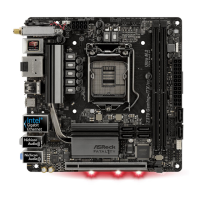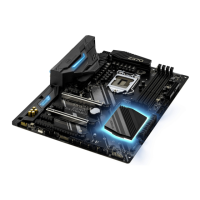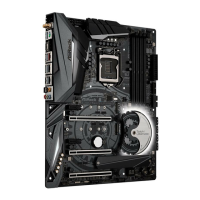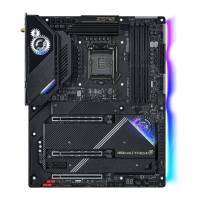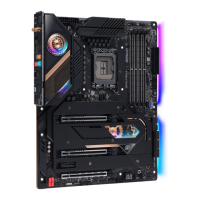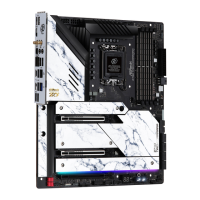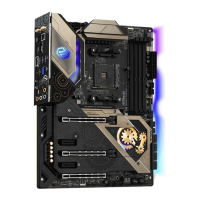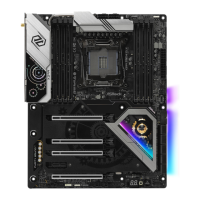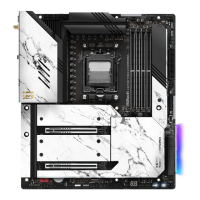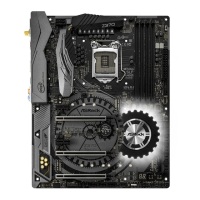
Do you have a question about the ASROCK Z370 Taichi and is the answer not in the manual?
| ECC | No |
|---|---|
| Memory channels | Dual-channel |
| Memory slots type | DIMM |
| Unbuffered memory | Yes |
| Number of memory slots | 4 |
| Supported memory types | DDR4-SDRAM |
| Maximum internal memory | 64 GB |
| Supported memory clock speeds | 2133, 4333 MHz |
| RAID levels | 0, 1, 5, 10 |
| Supported storage drive types | HDD & SSD |
| Supported storage drive interfaces | M.2, SATA III |
| Audio chip | Realtek ALC1220 |
| Cooling type | Passive |
| Certification | FCC, CE, ErP/EuP ready |
| Component for | PC |
| Motherboard chipset | Intel® Z370 |
| PC health monitoring | CPU, FAN, Power supply, Temperature, Voltage |
| Audio output channels | 7.1 channels |
| Motherboard form factor | ATX |
| Motherboard chipset family | Intel |
| Compatible processor series | Intel Core i3, Intel Core i5, Intel Core i7 |
| Supported processor sockets | LGA 1151 (Socket H4) |
| Maximum number of SMP processors | 1 |
| DirectX version | 12.0 |
| Maximum resolution | 4096 x 2304 pixels |
| Parallel processing technology support | 2-Way CrossFireX, 2-Way SLI, 3-Way CrossFireX, Quad-GPU CrossFireX, Quad-GPU SLI |
| Number of SATA connectors | 8 |
| Number of Parallel ATA connectors | 0 |
| USB 3.2 Gen 1 (3.1 Gen 1) connectors | 3 |
| BIOS type | UEFI |
| ACPI version | 6.0 |
| BIOS memory size | 16 Mbit |
| System Management BIOS (SMBIOS) version | 2.7 |
| USB 2.0 ports quantity | USB 2.0 ports have a data transmission speed of 480 Mbps, and are backwards compatible with USB 1.1 ports. You can connect all kinds of peripheral devices to them. |
| LAN controller | Intel I211-AT, Intel I219V |
| Wi-Fi standards | 802.11a, Wi-Fi 5 (802.11ac), 802.11b, 802.11g, Wi-Fi 4 (802.11n) |
| Bluetooth version | 4.2 |
| Ethernet interface type | Gigabit Ethernet |
| Cables included | SATA |
| Harmonized System (HS) code | 84733020 |
| Depth | - mm |
|---|---|
| Width | 244 mm |
| Height | 305 mm |
Lists all items included in the motherboard package.
Provides detailed technical information about the motherboard's hardware features.
Diagram showing the placement and identification of motherboard components.
Details the rear panel connectors and their functions for external devices.
Explains the integrated wireless module and antenna installation.
Essential safety guidelines and handling procedures before installing components.
Step-by-step instructions for safely installing the processor onto the motherboard socket.
Guide to mounting the CPU cooler and connecting its fan header.
Procedure for inserting DDR4 memory modules into the motherboard slots.
Details on using PCIe slots for graphics cards and other expansion devices.
Explanation of the function and configuration of motherboard jumpers.
Identifies and describes internal motherboard connectors for case components.
Information on the function of onboard switches like Clear CMOS and XMP.
Guide to interpreting the diagnostic codes displayed by the Dr. Debug LED.
Instructions for setting up NVIDIA SLI and Quad SLI configurations.
Instructions for setting up AMD CrossFireX configurations.
Steps for installing M.2 SSDs in the M2_3 socket.
Steps for installing M.2 SSDs in the M2_1 and M2_2 sockets.
Guide to installing essential motherboard drivers from the support CD.
Overview and usage of ASRock's system tuning and monitoring utility.
Instructions for managing software, apps, and BIOS/driver updates.
Details on connecting and customizing RGB LED lighting effects.
Overview of the UEFI SETUP UTILITY and how to access it.
Explanation of the user-friendly BIOS interface for system status checks.
Introduction to the comprehensive BIOS configuration options.
Description of the system overview displayed on the UEFI Main screen.
Settings for system overclocking, including CPU and GPU tuning.
Access to detailed system configurations for various hardware components.
Description of utility tools available within the UEFI setup environment.
Monitoring system temperatures, fan speeds, and voltages.
Configuration of supervisor and user passwords for system access.
Settings for boot device priority and startup options.
Options for saving, discarding changes, and exiting the UEFI utility.
